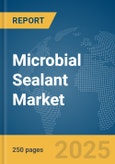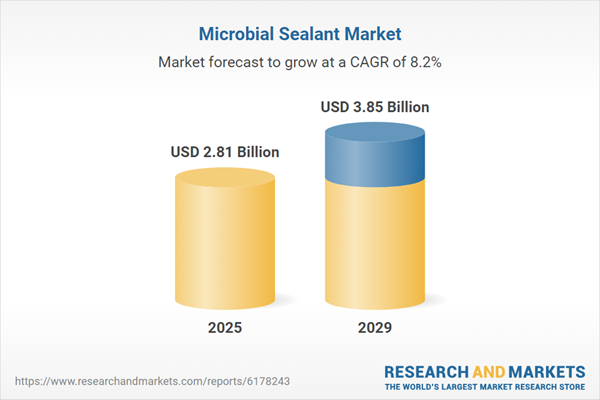The microbial sealant market size is expected to see strong growth in the next few years. It will grow to $3.85 billion in 2029 at a compound annual growth rate (CAGR) of 8.2%. The growth during the forecast period is expected to be supported by greater adoption of minimally invasive surgeries, increased focus on infection control protocols, rising demand for antimicrobial surgical solutions, expansion of outpatient and ambulatory surgical centers, regulatory support for advanced surgical products, and heightened awareness of surgical site infection prevention among healthcare providers. Key trends anticipated in the forecast period include innovations in antimicrobial formulations, development of faster-drying sealants, integration with minimally invasive surgical techniques, adoption of biocompatible and eco-friendly materials, and the use of nanotechnology for enhanced protection.
The microbial sealant market is expected to grow due to the rising number of surgeries in the future. Surgery is a medical procedure where doctors use instruments to treat injuries, diseases, or conditions by making incisions or repairing internal tissues and organs. The frequency of surgeries is increasing because of the growing occurrence of chronic diseases that often require operative treatment. Microbial sealants aid surgeries by forming a durable barrier on the skin that prevents microbial contamination, thereby lowering the risk of surgical site infections and promoting a safer surgical environment. For example, in April 2025, the Australian Institute of Health and Welfare, a government organization based in Australia, reported that public hospitals recorded 778,500 admissions from elective surgery waitlists in 2023-24, representing a 5.8 percent increase compared to 735,500 admissions in 2022-23. This trend indicates that the growing number of surgeries is driving demand in the microbial sealant market.
The microbial sealant market is also expected to expand due to the rising incidence of sports injuries. Sports injuries are physical damages sustained during participation in sports or recreational activities. These injuries are increasing as a result of more engagement in high-intensity physical activities and competitive sports. Microbial sealants help manage sports injuries by creating an antimicrobial barrier over wounds, reducing the chance of infection and promoting faster healing. For instance, in November 2023, Howden Group Holdings Ltd, a UK-based insurance intermediary, reported that the severity of ankle injuries in the English Premier League rose by 170 percent between October 2022 and January 2023. Injuries to the calf and shin increased by 200 percent, and hamstring injuries went up by 130 percent following the FIFA World Cup Qatar 2022. Thus, the growing number of sports injuries is boosting the microbial sealant market.
In July 2023, H.B. Fuller Company, a US-based chemicals manufacturer, acquired Adhezion Biomedical for an undisclosed sum. This acquisition strengthens H.B. Fuller’s position in healthcare adhesives by incorporating advanced cyanoacrylate technologies used for surgical care, wound management, and infection prevention. Adhezion Biomedical is a US-based medical company that produces microbial sealants.
Major players in the microbial sealant market are Johnson & Johnson, Medtronic plc, 3M Company, The Sherwin-Williams Company, Kimberly-Clark Health Care, Becton Dickinson and Company (BD), Evonik Industries AG, Sika AG, B. Braun AG, H.B. Fuller Company, Bostik Inc., Integra LifeSciences Holdings Corporation, Soudal N.V., Technetics Group, Advanced Medical Solutions Group plc, Polymères Technologies Inc., Microban International Ltd., Hodgson Sealants Ltd., Nano-Care Deutschland AG, BioCote Limited.
North America was the largest region in the microbial sealant market in 2024. Asia-Pacific is expected to be the fastest-growing region in the forecast period. The regions covered in microbial sealant report are Asia-Pacific, Western Europe, Eastern Europe, North America, South America, Middle East and Africa. The countries covered in the microbial sealant market report are Australia, Brazil, China, France, Germany, India, Indonesia, Japan, Russia, South Korea, UK, USA, Canada, Italy, Spain.
Note that the outlook for this market is being affected by rapid changes in trade relations and tariffs globally. The report will be updated prior to delivery to reflect the latest status, including revised forecasts and quantified impact analysis. The report’s Recommendations and Conclusions sections will be updated to give strategies for entities dealing with the fast-moving international environment.
The sudden escalation of U.S. tariffs and the consequent trade frictions in spring 2025 are severely impacting the pharmaceutical companies contend with tariffs on APIs, glass vials, and lab equipment inputs with few alternative sources. Generic drug makers, operating on razor-thin margins, are especially vulnerable, with some reducing production of low-profit medicines. Biotech firms face delays in clinical trials due to tariff-related shortages of specialized reagents. In response, the industry is expanding API production in India and Europe, increasing inventory stockpiles, and pushing for trade exemptions for essential medicines.
A microbial sealant is a liquid medical product applied to a patient’s skin prior to surgery. Upon application, it forms a protective film that locks in skin flora and prevents bacteria from entering the surgical incision, thereby reducing the risk of surgical site infections.
The primary product categories of microbial sealants are natural microbial sealants and synthetic microbial sealants. Natural microbial sealants are made from biological materials such as proteins, polysaccharides, and plant- or animal-derived polymers that are biocompatible and biodegradable. They are available in forms such as ethylene oxide and cyanoacrylate and are widely used in applications including surgical procedures, wound care, dental care, and related areas. End users include hospitals, ambulatory surgical centers, clinics, and other healthcare facilities.
The microbial sealant market research report is one of a series of new reports that provides microbial sealant market statistics, including the microbial sealant industry global market size, regional shares, competitors with the microbial sealant market share, detailed microbial sealant market segments, market trends, and opportunities, and any further data you may need to thrive in the microbial sealant industry. This microbial sealant market research report delivers a complete perspective of everything you need, with an in-depth analysis of the current and future scenarios of the industry.
The microbial sealant market consists of sales of acrylic polymer sealants, silicone-based sealants, polyurethane sealants, hydrophilic gel sealants, and antimicrobial polymer coatings. Values in this market are ‘factory gate’ values, that is, the value of goods sold by the manufacturers or creators of the goods, whether to other entities (including downstream manufacturers, wholesalers, distributors, and retailers) or directly to end customers. The value of goods in this market includes related services sold by the creators of the goods.
The market value is defined as the revenues that enterprises gain from the sale of goods and/or services within the specified market and geography through sales, grants, or donations in terms of the currency (in USD unless otherwise specified).
The revenues for a specified geography are consumption values and are revenues generated by organizations in the specified geography within the market, irrespective of where they are produced. It does not include revenues from resales along the supply chain, either further along the supply chain or as part of other products.
This product will be delivered within 3-5 business days.
Table of Contents
Executive Summary
Microbial Sealant Global Market Report 2025 provides strategists, marketers and senior management with the critical information they need to assess the market.This report focuses on microbial sealant market which is experiencing strong growth. The report gives a guide to the trends which will be shaping the market over the next ten years and beyond.
Reasons to Purchase:
- Gain a truly global perspective with the most comprehensive report available on this market covering 15 geographies.
- Assess the impact of key macro factors such as geopolitical conflicts, trade policies and tariffs, post-pandemic supply chain realignment, inflation and interest rate fluctuations, and evolving regulatory landscapes.
- Create regional and country strategies on the basis of local data and analysis.
- Identify growth segments for investment.
- Outperform competitors using forecast data and the drivers and trends shaping the market.
- Understand customers based on the latest market shares.
- Benchmark performance against key competitors.
- Suitable for supporting your internal and external presentations with reliable high quality data and analysis
- Report will be updated with the latest data and delivered to you along with an Excel data sheet for easy data extraction and analysis.
- All data from the report will also be delivered in an excel dashboard format.
Description
Where is the largest and fastest growing market for microbial sealant? How does the market relate to the overall economy, demography and other similar markets? What forces will shape the market going forward, including technological disruption, regulatory shifts, and changing consumer preferences? The microbial sealant market global report answers all these questions and many more.The report covers market characteristics, size and growth, segmentation, regional and country breakdowns, competitive landscape, market shares, trends and strategies for this market. It traces the market’s historic and forecast market growth by geography.
- The market characteristics section of the report defines and explains the market.
- The market size section gives the market size ($b) covering both the historic growth of the market, and forecasting its development.
- The forecasts are made after considering the major factors currently impacting the market. These include: technological advancements such as AI and automation, Russia-Ukraine war, trade tariffs (government-imposed import/export duties), elevated inflation and interest rates.
- Market segmentations break down the market into sub markets.
- The regional and country breakdowns section gives an analysis of the market in each geography and the size of the market by geography and compares their historic and forecast growth.
- The competitive landscape chapter gives a description of the competitive nature of the market, market shares, and a description of the leading companies. Key financial deals which have shaped the market in recent years are identified.
- The trends and strategies section analyses the shape of the market as it emerges from the crisis and suggests how companies can grow as the market recovers.
Report Scope
Markets Covered:
1) By Product Type: Natural Microbial Sealants; Synthetic Microbial Sealants2) By Type: Ethylene Oxide; Cyanoacrylate
3) By Application: Surgical Procedures; Wound Care; Dental Care; Other Applications
4) By End-User: Hospitals; Ambulatory Surgical Centers; Clinics; Other End Users
Subsegments:
1) By Natural Microbial Sealants: Plant-Derived Sealants; Animal-Derived Sealants; Marine-Derived Sealants; Microorganism-Derived Sealants2) By Synthetic Microbial Sealants: Polymeric Sealants; Cyanoacrylate-Based Sealants; Hydrogel-based Sealants; Composite Or Hybrid Sealants
Companies Mentioned: Johnson & Johnson; Medtronic plc; 3M Company; The Sherwin-Williams Company; Kimberly-Clark Health Care; Becton Dickinson and Company (BD); Evonik Industries AG; Sika AG; B. Braun AG; H.B. Fuller Company; Bostik Inc.; Integra LifeSciences Holdings Corporation; Soudal N.V.; Technetics Group; Advanced Medical Solutions Group plc; Polymères Technologies Inc.; Microban International Ltd.; Hodgson Sealants Ltd.; Nano-Care Deutschland AG; BioCote Limited
Countries: Australia; Brazil; China; France; Germany; India; Indonesia; Japan; Russia; South Korea; UK; USA; Canada; Italy; Spain
Regions: Asia-Pacific; Western Europe; Eastern Europe; North America; South America; Middle East; Africa
Time Series: Five years historic and ten years forecast.
Data: Ratios of market size and growth to related markets, GDP proportions, expenditure per capita
Data Segmentation: Country and regional historic and forecast data, market share of competitors, market segments.
Sourcing and Referencing: Data and analysis throughout the report is sourced using end notes.
Delivery Format: PDF, Word and Excel Data Dashboard.
Companies Mentioned
The companies featured in this Microbial Sealant market report include:- Johnson & Johnson
- Medtronic plc
- 3M Company
- The Sherwin-Williams Company
- Kimberly-Clark Health Care
- Becton Dickinson and Company (BD)
- Evonik Industries AG
- Sika AG
- B. Braun AG
- H.B. Fuller Company
- Bostik Inc.
- Integra LifeSciences Holdings Corporation
- Soudal N.V.
- Technetics Group
- Advanced Medical Solutions Group plc
- Polymères Technologies Inc.
- Microban International Ltd.
- Hodgson Sealants Ltd.
- Nano-Care Deutschland AG
- BioCote Limited
Table Information
| Report Attribute | Details |
|---|---|
| No. of Pages | 250 |
| Published | October 2025 |
| Forecast Period | 2025 - 2029 |
| Estimated Market Value ( USD | $ 2.81 Billion |
| Forecasted Market Value ( USD | $ 3.85 Billion |
| Compound Annual Growth Rate | 8.2% |
| Regions Covered | Global |
| No. of Companies Mentioned | 21 |









